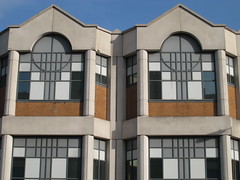Postmodernism, as described by Wikipedia: does it affirm the Magnet PAC as a postmodern design?
In the last quarter of the 20th century some architects started to turn away from modern Functionalism (Magnet campus proper) which they viewed as boring, and which some of the public considered unwelcoming and even unpleasant.
These architects turned towards the past, quoting past aspects of various buildings and melding them together (even sometimes in an inharmonious manner) to create a new means of designing buildings.
A vivid example of this new approach was that Postmodernism saw the comeback of pillars and other elements of premodern designs, sometimes adapting classical Greek and Roman examples (but not simply recreating them, as was done in neoclassical architecture). As in Magnet's Doric columns in the porticos.
In Modernism, the pillar (as a design feature) was either replaced by other technological means such as cantilevers, or masked completely by curtain wall façades.
The revival of the pillar was an aesthetic, rather than a technological, necessity. Modernist high-rise buildings had become in most instances monolithic, rejecting the concept of a stack of varied design elements for a single vocabulary from ground level to the top, in the most extreme cases even using a constant "footprint" (with no tapering or "wedding cake" design), with the building sometimes even suggesting the possibility of a single metallic extrusion directly from the ground, mostly by eliminating visual horizontal elements — this was seen most strictly in Minoru Yamasaki's World Trade Center buildings.
Subscribe to:
Post Comments (Atom)





No comments:
Post a Comment